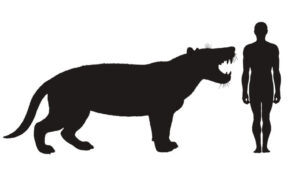Ancient species of giant carnivore discovered in Kenya

Illustration by Mauricio Anton
One of the largest terrestrial carnivorous mammals ever known has been identified from teeth and bone fragments in western Kenya.
The genus name of the new species, Simbakubwa kutokaafrika, is derived from the Swahili words ‘simba’ meaning ‘lion’, ‘kubwa’ meaning ‘big’ and kutokaafrika meaning ‘from Africa.’ It is revealed in the Journal of Vertebrate Paleontology.
Well-preserved dental specimens enabled researchers from Ohio University, US, to estimate the body mass of the carnivore. At as large as 1500 kg, it was the dominant meat-eater on the landscape, capable of preying upon herbivores as large as elephant-like proboscideans and hippopotamus-like anthracotheres. Simbakubwa was one of the largest terrestrial carnivorous mammals ever known.
“Based on its massive teeth, Simbakubwa was a specialized ‘hypercarnivore’ that was significantly larger than the modern lion and possibly larger than a polar bear,” says lead author Dr Matthew Borths of Duke University, who conducted the research as a postdoc at Ohio University.
Simbakubwa is a remarkably large predator collected from a site sampling the beginning of the Neogene period – around 23 million years ago in the early Miocene epoch. The authors suggest that as the Afro-Arabian landscape underwent profound environmental change, it could support larger-bodied herbivores that in turn were preyed upon by larger-bodied carnivores. Once they became gigantic, like Simbakubwa, the conditions that supported this new morphology appear to have persisted for millions of years.

Illustration by Mauricio Anton
“Gigantic hyaenodonts likely stalked the landscape by the end of the Paleogene, but Simbakubwa represents the earliest definitive fossil evidence of an ecomorphological experiment in hypercarnivory that succeeded in ecosystems on three continents for an interval spanning well over 10 million years,” says co-author Nancy Stevens.
The authors examined a partial lower jaw complete with a canine, premolar, and molar as well as additional teeth and bones. The canines were remarkably unworn, suggesting the specimen was a young adult. Despite its young age, the jaw is much larger than that of a modern adult male lion. The canines show that carnivore was adapted for shearing flesh, while sharp cusps on the molars helped it to crack the bones of its prey.
The material was excavated decades ago from Meswa Bridge, one of the oldest Neogene localities in Sub-Saharan Africa. It was examined at the Nairobi National Museum. The material was originally thought to belong to a smaller species, Hyainailouros napakensis. In the present study, the researchers reveal anatomical distinctions between these two species, including the larger size of the teeth and bones.
The discovery also sheds also new light on how such giant carnivores fundamentally shaped – and were shaped by – the Old World ecosystem that gave rise to our immediate hominoid relatives. It suggests that the hyainailourine clade was not part of a fading, defeated Afro-Arabian fauna, but rather was integral to a network of ecosystems in flux as animals and plants from Afro-Arabia met and integrated with Eurasian ones. It supports the hypothesis, tested in this study using phylogenetic analysis, that the large-bodied hyainailourines originated in Afro-Arabia before dispersing to Eurasia during the early Miocene via the Gomphothere land bridge. Until it and other hyainailourines became extinct near the beginning of the Pliocene, Simbakubwa occupied a key predatory niche no longer observed in the ecosystems of today.